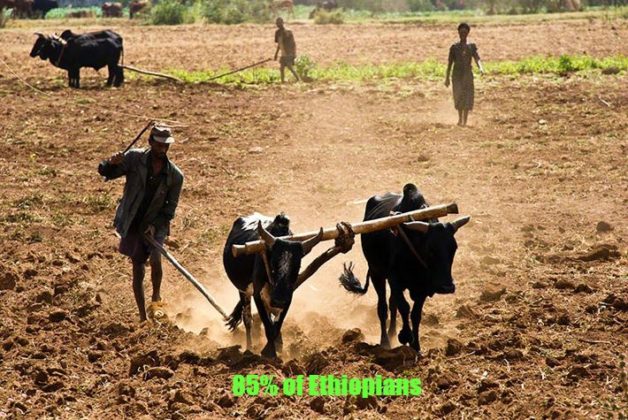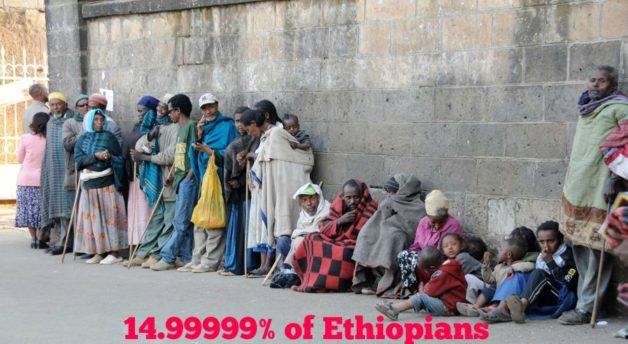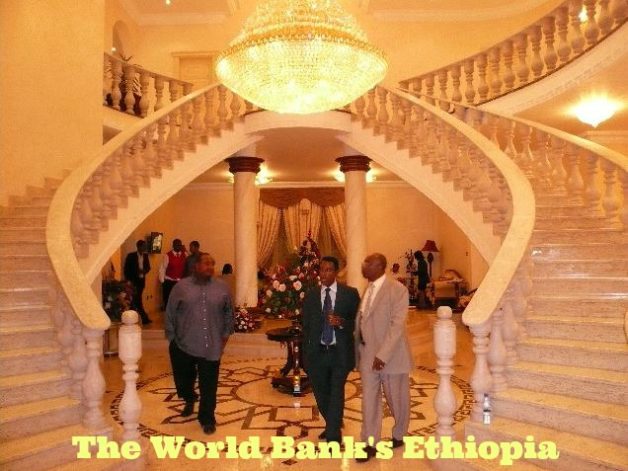The World Bankliars in Ethiopia
 The World Bank of Liars
The World Bank of Liars
I have been wrangling with the World Bank of Lies, Damned Lies and Statislies in Ethiopia for the past few years.
I have been trying to keep them honest. I once offered a deal to The World Bank: If they stopped lying by statistics (statislies) about economic “growth” and “development” in Ethiopia, I will stop telling the truth about their malfeasance and wicked deeds in Ethiopia.
I thought we had reached an unwritten silent deal. But not so, apparently.
On December 2, 2016, The World Bank issued its report, “Why so Idle? Wages and Employment in a Crowded Labor Market”.
Today I ask The World Bank, “Why so many idle statistical lies about Ethiopia?” Why so many World Bank fake news about Ethiopia?
I am sick and tired of being sick and tired of the lies, damned lies and statislies The World Bank publishes on Ethiopia.
In my January 2015 commentary, “World Bank-ruptcy in Ethiopia”, I condemned the World Bank for lying about the so-called “Ethiopia Protection of Basic Services Project (PBS)” it financed which directly supported the “Ethiopian Government’s Villagization Program in Gambella Region.” The World Bank gave money to the Thugtatorship of the Tigrean Peoples Liberation Front (T-TPLF) to forcibly remove the Anuak Indigenous People in Gambella, Western Ethiopia, so that their fertile ancestral land could be given away for pennies to fly-by-night investors. The World Bank pled plausible deniability in the T-TPLF’s displacement and deracination of the of the Anuak people. In 2012, Human Rights Watch (HRW) issued a 115-page damning investigative report entitled “ ‘WAITING HERE FOR DEATH’: Displacement and ‘Villagization’ in Ethiopia’s Gambella Region”, documenting the crimes against humanity committed by the T-TPLF using World Bank and other funds provided by the gang of international poverty pimps who call themselves the “Development Assistance Group” (DAG).
In my February 2, 2015 commentary , “The World Bank and Ethiopia’s ‘Growth and Transformation’”, I debunked the World Bank’s hyped narrative and lies aimed at extolling the skillful management of the Ethiopian economy by the T-TPLF and its own self-glorification that it and the other donors and loaners have played a central and decisive role in lifting out of poverty and transforming a once famine-stricken country into a shining example of loan- and aid-based development (an oxymoronic claim on its face).
In my February 8, 2015 commentary , “Ethiopia’s ‘Odious Debt’ to the Odious World Bank”, I argued that the Ethiopia’s “odious debt” (illegitimate national debt incurred and pocketed by the T-TPLF in the name of Ethiopia) to The World Bank should not be enforceable against the people of Ethiopia. The T-TPLF is a criminal racketeering regime that has not only stolen tens of billions of dollars from the Ethiopian people over the past quarter century but today literally has taken one hundred million Ethiopians hostage in Ethiopia by declaring a “state of emergency”. Hostages must never be liable for the criminal acts of their abductors.
In my November 2015 commentary, “Ethiopia and the World Bank of Lies, Damned Lies and Statislies”, I marveled at how low those doggone liars at The World Bank will stoop to hatch out lies, fabricate damned lies and manufacture statistics just to kiss up to a corrupt-to-the-bone thug regime and bend over backwards to cover up the truth about poverty, unemployment and corruption in Ethiopia.
In January 2017, I am back to square one. I must rise up once more to expose another big lie report by the World Bank.
One caveat: It is not that I am out to condemn any report issued by the World Bank on Ethiopia. Indeed, I applauded and expounded on The World Bank’s landmark study of corruption in T-TPLF Ethiopia.
The 2012 World Bank report, “Diagnosing Corruption in Ethiopia: Perceptions, Realities, and the Way Forward for Key Sectors”, is an extraordinary, unprecedented and path-breaking work of policy analysis on corruption ever done by the Bank anywhere (to my knowledge).
What is extraordinary about the 417-page report is that The Bank critically examines T-TPLF corruption in a number of areas including health, education, rural water supply, justice, construction, land, telecommunication and mining sectors. The “clinical” report is aptly titled “Diagnosing Corruption in Ethiopia” because corruption is a cancer that has spread and metastasized in the Ethiopian body politics; and the T-TPLF is the deadly vector-pathogen .
I generated several commentaries on that “diagnostic” report.[1] In my commentaries, I sought to remove the bureaucratic language and lay bare the essential message of the report to my readers: The T-TPLF operates an empire of corruption in Ethiopia and is hell-bent on dragging one hundred million people into total political and economic collapse.
The World Bank’s December 2016 report
In its December 2016 77-page report, The World Bank makes a number of claims by relying exclusively on T-TPLF-provided statistics:
Strong economic growth continued in 2014/15, but the drought slowed down Ethiopia’s growth to 8 percent in 2015/16.
Inflation is remarkable (sic) stable given the recent drought and even declining; it stood at 5.6 percent in October 2016 (at p.5).
[On January 5, 2017, the T-TPLF publicly announced, “inflation dropped to 6.7 percent in December from 7.0 percent the previous month [November].”) Did inflation rise to 7 percent in November from the 5.6 percent in October (an increase of 1.4 percent) and drop to 6.7 percent in December (a drop of 1.1 percent)? So much for statislies of the gang that couldn’t lie straight. If only the Bankliars had spoken about inflation to the man and woman in the street and countryside struggling to make ends meet. As of 1/8/2017, the black market exchange rate is USD$1= 27 ETH birr. The official rate is 22 birr.]
A decade of remarkable double digit growth rates helped the economy to cope well with the most recent challenges encountered in 2015/16. In fact, the ability to keep growth positive is a remarkable achievement for the Government. [Does that mean the Ethiopian economy doubled in 10 years?]
Many urban labor market trends are moving in the right direction although there has been little change in the structure of urban labor markets over time. Labor participation is increasing, and unemployment and underemployment are falling.
It was to be expected that Ethiopia’s strong economic growth would slow down in 2015/16 due to the recent drought… While there was some uncertainty about the actual impact of the drought, preliminary actual figures from the Government for 2015/16 show now that the growth rate was 8 percent, in line with (sic). (Emphasis added.)
What is the factual basis for these claims?
Is “economic growth” in Ethiopia 8 percent in 2015/16 actually down from 10.9 percent for the last decade?
Was inflation at 5.6 percent in October 2016? Or was it 6.7 percent? Perhaps 7 percent? How about 1 percent? Is Ethiopia experiencing hyperinflation? Is Ethiopia the next Zimbabwe or Venezuela?
Did Ethiopia really have “a decade of remarkable double digit growth over the past decade”? [In a November 2015 Press Release, The World Bank announced that Ethiopia’s “GDP growth average[ed] 10.9 percent in 2004-2014. Ethiopia has moved from the second poorest in the world in 2000 and, if it can keep the current pace, it’s on its way towards becoming a middle income country by 2025.”]
Is labor participation in Ethiopia “increasing, and unemployment and underemployment falling”?
Garbage in, Garbage out: Is The World Bank the PR Team, propaganda agency, for the T-TPLF?
Having studied numerous World Bank reports on Ethiopia over the years, I have come to the conclusion that The World Bank issues its periodic economic “reports” for two purposes:
1) to propagate and sustain the illusion that the T-TPLF is doing economic miracles in Ethiopia, and
2) by glorifying the T-TPLF ensure that The World Bank bureaucrats and their assorted international poverty pimps and ticks will continue to feast on the debt-fattened Ethiopian cash cow.
Must The World Bank issue such hogwash reports?
My view is that the so-called experts who help write these reports (see, e.g. acknowledgement on p. 2) on Ethiopia after being paid a king’s ransom, including some who call themselves “Poverty Economists” (“Poverty Pimps” is more apt), do so believing that no Ethiopian will read it, and if any did, they would not understand it; and certainly no Ethiopian will dare to challenge the mighty, mighty World Bank by demanding that they to put up their evidence or shut the hell up. Suffice it to say that every report The World Bank publishes on Ethiopia will be scrutinized, anatomized and criticized.
The first incontrovertible fact is that The World Bank’s reports and recommendations on Ethiopia are based on bogus statistical reports and analyses provided by the T-TPLF. Indeed, The Bank gives lip service to the fact that its data come “from the statistical systems of member countries”.
The second irrefutable fact is that the data provided by the T-TPLF to The World Bank are junk data.
Specifically, in its December 2016 report, the World Bank acknowledges receiving all of the “data” it used in its report from the following T-TPLF agencies: the “Ministry of Finance and Economic Development [MOFED]”, the “Central Statistics Agency [CSA]”, “National Bank of Ethiopia [NBE]”, “Ethiopian Grain Trade Enterprise [EGTE]”, Urban Employment and Unemployment Survey conducted by the CSA [UEUS]. (See e.g. pp. 12, 15, 18, 21, 33, 34, 43, 64, 65.) These agencies are under the thumbs of T-TPLF bosses.
Using the T-TPLF junk data, The World Bank claims to have performed compilations, calculations and analysis using “Macro-Fiscal Forecasting Model”, “debt sustainability analysis” and determined employment rates and patterns. (See e.g. pp. 38-39, 44, 46, 49, 50, 51, 52, 56, 68.)
Not to sound cynical, I have the sense that The World Bank experts likely sat in a posh 5-star hotel in Addis Ababa, looked over reams of junk data and statistics provided by the T-TPLF and wrote up their report sipping hors d’âge Cognac.
I can only imagine what could happen to World Bank experts/consultants who dared to tell the truth about the Ethiopian economy. Instant excommunication?!
Are The World Bank economic reports on Ethiopia worth the paper they are written on?
As I have previously argued, the World Bank in Ethiopia is a window dressing institution. Its officials and so-called experts preparing reports are groupies and toadies of the T-TPLF.
In a November 2014, the Inspection Panel of The World Bank concluded that the Bank’s managers and bosses in Ethiopia are lazy, do not seem to know what they are doing and manifestly do not care about the professional performance of their responsibilities or diligent exercise of their fiduciary duties with respect to the PBS III program. They relegated their fiduciary duties in that program to corrupt woreda (local) officials. Likewise, they have also relegated the task of data collection and analysis to other equally corrupted T-TPLF institutions including the CSA and others.
The following facts about the data used by the World Bank in its economic reports on Ethiopia should be clearly stated:
First, the economic “statistics” upon which The World Bank (and the other donors and loaners) relies on for Ethiopia are NOT based on the Bank’s or other independently collected data or analyses. All of the “raw” data used by The Bank are generated by T-TPLF agencies. As a matter of policy and practice, The World Bank accepts T-TPLF statistics on face value and irresponsibly propagates them to the rest of the world as true, reliable and accurate.
Second, the World Bank does not verify on its own the accuracy, validity and reliability of the statistics cooked up by T-TPLF agencies. The Bank merely makes occasional disclaimer disclosures about the integrity of the data in fine print.
In October 2013, the International Monetary Fund (IMF) for all intents and purposes declared it has no confidence in the cooked data of the T-TPLF and had stopped using CSA statistics and began using its own estimates. The IMF stated:
GDP statistics in Ethiopia are subject to significant weaknesses… Substantial information gaps on the health of the financial sector remain as the mission did not have access to detailed banks’ balance sheet data in order to undertake a banking sector diagnostic. In addition, fiscal and BOP [balance of payments] statistics require improvements. For example, comprehensive public sector data, including on public enterprises, are still lacking and would be desirable for a proper assessment of public sector finances. [Emphasis added.] (N.B. These are the same GDP statistics The World Bank used in its 2015 Press Release, over two years after the IMF declared T-TPLF data junk, to claim Ethiopia is “on its way towards becoming a middle income country by 2025.”)
Third, the T-TPLF agencies do not follow international standards for statistical data collection and reporting. Consequently, reliable data on the performance of both the public and private sectors is nonexistent. There is substantial evidence from informant(s) with firsthand knowledge of CSA operations and activities that systemic falsification of economic and other data are encouraged and rewarded by the T-TPLF bosses. Official statistics are deliberately overstated and squeezed to yield exaggerated numbers on the economy’s growth while understating other factors such as inflation.
With respect to the public sector, the CSA and the other T-TPLF reporting agencies are “encouraged” and “ordered” to “cook” the statistics. Those who have worked in the CSA and familiar with its inner working indicate that CSA personnel can readily testify to the fact that CSA staff are ordered, directly and indirectly, to massage the statistics to make the T-TPLF look good.
With respect to the private sector, reliable data is virtually nonexistent. Private and even state-owned enterprises seeking to avoid taxes, regulation or other sanctions deliberately underreport revenues, output and expenses. Similarly, local officials and bureaucrats who may not necessarily want to report factually inaccurate data are forced to do so because their own performance evaluation depends on overly favorable figures. They often overstate politically preferred facts and understate politically incorrect facts that reflect negatively on the T-TPLF. As a result, it is nearly impossible to distinguish between real and paper investments or measure the real performance of the private sector.
The World Bank knows T-TPLF economic statistics are junk data
The T-TPLF’s Central Statistics Agency (CSA) is a den of lies, damned lies and statistics. The World Bank knows it; so does everybody, particularly those working in the CSA. This is not to condemn or malign the hardworking professionals in the CSA, but to point out the perversion of that agency by the T-TPLF into a Central Statistics Lie Factory.
It is well-known by the loaners and donors that the CSA simply does not have the institutional capacity or technical and human resources to collect, analyze and disseminate accurate economic statistics.
Because the CSA’s serious “capacity” problems, in May 2014, the World Bank issued a “Project Appraisal Document” intending to commit USD$10 million “to enhance the capacity of the Central Statistical Agency (CSA) at the organizational, human, and physical levels in order to produce and disseminate reliable, accessible, and timely statistics.”
On September 4, 2014, a “team of 15 IBM experts presented its recommendations to Ethiopian leaders” on a variety of statistical data collection methodologies and processes including “text-based communications”, “integrated IT system”, “collection and analysis of key labor market data”, “mobile and analytics technologies to gather and analyze data about nutrition, water, sanitation, and hygiene”.
The $10 million “Project” is said to have 4 components. Accordingly, the Bank allocated USD$4.9 million for “Organizational and Infrastructure Capacity Development”, USD$ 1.5 million for “Statistical Data Development and Management”, USD$1.9 million for “Statistical Methodology, Standards and Data Quality Assurance and Information Dissemination” and USD$1.7 million for “Monitoring and Evaluation”.
It is worth noting that less than 20 percent of the $10 million actually goes to improve data quality assurance and information dissemination.
The outcome of this “Project” effort is documented on The World Bank website.
In its first Project update report dated June 29, 2015, The Bank congratulated itself for “adopting EDQAF [Ethiopian Data Quality Assessment Framework] manual, “use of Microsoft- and Android-based software for data collection”, “training staff from 25 branch offices” and the “hiring of a project audit firm, consultants and the finalization of the operation manual.”
In its second Project update report dated February 10, 2016, The Bank reported performing an “external audit report” (which deemed the Bank’s performance “unqualified clean” (ha!)), organized “a field mission to check the status of construction”, provided “pilot training courses” “with two video link sessions” in which “188 government officials were trained on (sic) survey design and statistical systems”, and conducted a “User Satisfaction Survey, with the help of an international consulting firm”.
In its third Project update report dated October 31, 2016, the Bank reported “launch[ing] of statistical awareness training” course, “engaged an international consulting firm for the development of a national business register” and that “CSA has opted for the use of administrative data from two primary sources: the Ministry of Trade (MOT, which records commercial registration processes) and the Ethiopian Revenue and Customs Authority (ERCA, which records tax registration and VAT and income tax data)”.
The closing date for the “Project” is June 30, 2017.
It seems that USD$10 million was allocated by The World Bank to feed its parasi-tick and ravenous “experts”, “consultants” and “auditors” and T-TPLF bosses and hacks.
The Project reports cited above speak for themselves, but for the World Bank to claim that it has “enhanced the capacity of the Central Statistical Agency (CSA) at the organizational, human, and physical levels in order to produce and disseminate reliable, accessible, and timely statistics” is at best a cruel joke.
My challenge to Ethiopian economists: Rise up and challenge the World Bank and the other international poverty pimps pimping in Ethiopia!
Why should we be concerned about World Bank junk reports?
I have observed over the years that far too many learned Ethiopians take a dismissive, cavalier and contemptuous attitude towards such reports. Many have told me that I should not be concerned about such reports because “everyone knows they are just lies” and “no one pays any attention to them”.
But lies unchallenged by truth have extraordinary power. It is the “lies” that are the basis for The World Bank to ensnare Ethiopia deeper into debt. When The World Bank bosses decide how much “loan to give to Ethiopia”, they rely on the lies, damned lies and statislies manufactured by their own bureaucrats using T-TPLF junk data. The World Bank “consultants” pimp themselves as experts on the suffering of the Ethiopian poor based on these lies. They extract astronomical fees to repeat the numbers and figures given to them by a gang of corrupt thugs and lend their “prestigious” names to give a patina of credibility to lies and damned lies. It is the lies told and retold through and by the World Bank and the other loaners and donors that the T-TPLF uses to proclaim itself as the Second Coming in Ethiopia.
Lies, damned lies and statislies are the powerful tools of oppressors. But, “In a time of universal deceit, telling truth is a revolutionary act.”
That is why I am issuing a challenge to all Ethiopian economists, statisticians and researchers to rise up and perform “revolutionary” acts by exposing the lies of the World Bank and the other international poverty pimps in Ethiopia.
I am certain that they can do a much better job of exposing The World Bank and other such institutions plying their trade in Ethiopia than I ever could.
That is why I challenge Ethiopian economists, statisticians and researchers to scrutinize and analyze every report issued by the international poverty pimps and expose their lies, damned lies and statislies to the Ethiopian public. The truth may not stop them from issuing their junk reports, but the truth will make them think twice about their arrogant lies because Ethiopia’s best and brightest are maintaining 24/7 vigilance to protect Ethiopia’s poor from the predatory international poverty pimps and parasi-ticks.
I am convinced that those who masquerade as helpers of the poor and present themselves as intermediaries on the side of the dispossessed and oppressed while lining their pockets and profiting from the victims of oppression should be exposed to public inquiry. The so-called “Poverty Economists” working to save the poor in Ethiopia while getting rich and swaggering in 5-star hotels must be exposed for the fraud they all are.
I ask Ethiopian economists, statisticians and researchers one question: If y’all don’t come together as ONE and form an impregnable line of defense against the lies, damned lies and statislies of The World Bank and the rest, who will?
Indeed, all Ethiopian intellectuals must band together as ONE and help our poor people fight the cancer in their body politics and the ticks on their skins.
“A lie repeated and unchallenged becomes the truth.” Unchallenged, these junk reports will ultimately serve to conceal the abysmal poverty and corruption in Ethiopia under T-TPLF rule.
The real and undeniable statistics on Ethiopia



[1] http://almariam.com/2013/03/31/land-and-ethiopias-corruptocracy/ ; http://almariam.com/2013/08/25/corruption-in-the-ethiopian-just-us-sector/ ; http://almariam.com/2013/11/03/mining-corruption-in-ethiopia/; http://almariam.com/2013/07/21/deconstructing-construction-corruption-in-ethiopia/; http://almariam.com/2013/05/20/ethiopia-the-corruption-game/;







